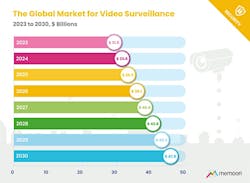Memoori: Hybrid Architectures, Cybersecurity Drive Change in Video Surveillance
The global video surveillance market continues its upward trajectory, driven by demand for security, operational intelligence and smarter connected systems, according to new research from Memoori. The firm’s latest report, "The Global Video Surveillance Business 2025–2030," forecasts that industry revenues will reach $47.9 billion by 2030, representing a compound annual growth rate of nearly 6%.
James McHale, CEO of Memoori, tells SecurityInfoWatch the sector’s underlying momentum remains solid, with both traditional and emerging use cases fueling expansion.
“The fundamental drivers of the market remain rising concerns about crime and terrorism,” he explained. “Organizations and governments continue investing in surveillance to protect people, assets and critical infrastructure.”
In addition to core safety and security applications, McHale points to smart city initiatives — particularly in Asia-Pacific and the Middle East — and the integration of AI analytics that extend surveillance value beyond incident detection.
Still, the report cautions that several forces could temper growth. Trade restrictions between the U.S. and China, along with NDAA compliance requirements, continue to disrupt supply chains and shift competitive dynamics. At the same time, cybersecurity vulnerabilities and tightening privacy regulations are lengthening procurement cycles as buyers perform deeper vendor due diligence.
“Economic uncertainty, particularly in commercial real estate, could delay capital projects,” McHale noted, adding that the skills gap in AI system deployment may also constrain adoption.
Hybrid architectures and the rise of AI-enabled cameras
Memoori’s research finds that AI-enabled cameras are quickly becoming the industry norm, with shipments expected to surpass non-AI cameras by 2028. These devices provide on-board capabilities such as object detection, behavior analysis and privacy-preserving redaction.
Rather than moving entirely to the cloud, the market is evolving toward hybrid architectures that balance edge, cloud and on-prem components. “Edge processing excels for latency-sensitive applications and addresses bandwidth constraints and data sovereignty requirements,” McHale said. “Cloud platforms handle long-term storage, compute-intensive analytics and centralized multi-site management.”
He added that video surveillance as a service (VSaaS) and related cloud offerings are “enabling recurring revenue models that are reshaping cost structures.”
For systems integrators, this means rethinking how value is created and sustained. “Integrators must develop expertise across the full stack to recommend the right architecture for each use case,” McHale advised. “More importantly, shift toward managed services and recurring revenue models rather than one-time installations. Invest in cybersecurity certification and knowledge as it should now be a core competency.”
He also recommends that integrators “build partnerships with AI software and cloud providers for best-of-breed solutions” and cultivate vertical market expertise tailored to healthcare, education and retail environments.
Consolidation Brings Efficiency and Risk
Between September 2023 and August 2025, Memoori tracked 24 M&A transactions totaling $3.8 billion in investment across 38 deals, much of it involving platform consolidation that merges hardware, software and cloud services.
“This creates both opportunities and risks,” McHale said. “Comprehensive platforms simplify integration and support, but reduced vendor diversity raises concerns about pricing, innovation and vendor lock-in.”
To protect themselves, integrators are “prioritizing open standards like ONVIF Profile M to ensure interoperability” and maintaining multi-vendor relationships to retain leverage and flexibility. Some are even developing value-added software layers for differentiation.
McHale recommends that channel partners closely evaluate “vendor financial health and product strategy” and “choose sustainable partners and demand clear product support commitments and migration paths.”
Cybersecurity and privacy take center stage
Memoori’s research underscores a sharp shift in buyer priorities as cybersecurity and privacy move to the forefront of system design. “Cybersecurity and privacy have moved from afterthoughts to primary selection criteria,” McHale said. “Video systems are attractive targets for hackers. They provide sensitive visual data and can be exploited for reconnaissance, privacy violations, or network infiltration.”
He emphasizes that security-by-design is now “mandatory,” requiring steps such as privacy impact assessments, network segmentation and hardened configurations before deployment. End users increasingly demand third-party certifications, penetration testing results and compliance with regulations such as GDPR, CCPA and biometric privacy laws.
Practical implications include “privacy masking, data minimization, automated retention policies and access audit trails,” McHale noted. Meanwhile, supply chain security — spurred by NDAA restrictions and nation-state concerns — means that “organizations require detailed manufacturing documentation and code audits.”
For integrators, cybersecurity expertise has become non-negotiable. “Those who position themselves as trusted advisors on security and privacy implications, not just equipment installers, will win the most valuable long-term relationships,” McHale said.
About the Author
Rodney Bosch
Editor-in-Chief/SecurityInfoWatch.com
Rodney Bosch is the Editor-in-Chief of SecurityInfoWatch.com. He has covered the security industry since 2006 for multiple major security publications. Reach him at [email protected].


